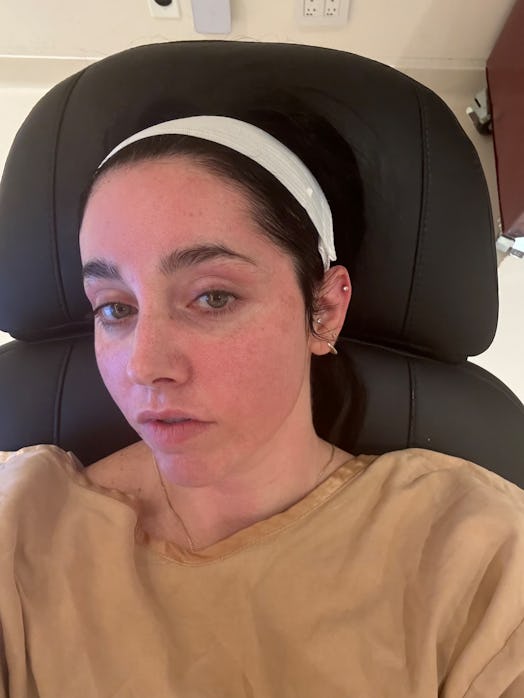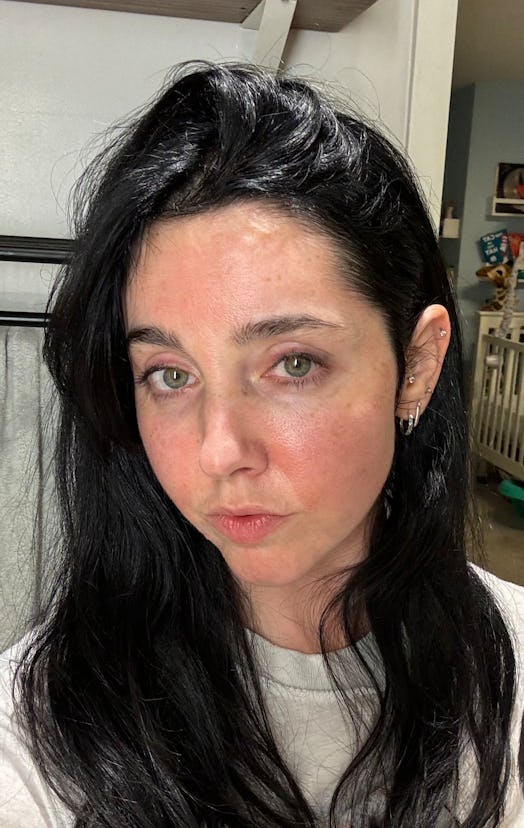I’m not anti-aging. However, I would like to continue to gather wisdom and move forward in my career with as smooth and tight a face as possible.
Since I’m what the youth would call middle-aged in my mid-30s And the gravity is starting to really take its toll on me, I’ve been looking for more drastic measures beyond my current routine of botox, fillers and collagen boosting.
When I received an email introducing the Miria laser, it felt like one of those times where the algorithm brings you exactly what you were just thinking straight to your screen. A new non-ablative treatment (lasers remove the top layer of skin, whereas non-ablative lasers do not) this non-invasive (read: doesn’t break skin or require incisions) The laser penetrates deep below the skin’s surface to tighten, reduce fine lines, and help reduce acne scarring and sun damage — all with only four to seven days of downtime.
Besides, as someone who has never tried a “serious” laser treatment Clean & Brightan entry-level laser that doesn’t penetrate as deep as Miria (and because it doesn’t go as deep, you need multiple sessions to see results) — I was intrigued. Since I’ve tried so many products and treatments in the name of younger looking skin, I thought it was time to give something more serious a go – something that really reaches the source of collagen production to stimulate it. Read on for everything you need to know about the Miria laser, including what it’s doing for my skin almost two months later.
What is the Miria Laser?
Miria is a new non-ablative FDA approved laser that goes deeper than any other laser to treat both the superficial and deep layers of the skin. The end result? Improved skin tone, texture and firmness.
Lasers, if you’re not familiar, are resurfacing treatments that use beams of light to penetrate the dermis to stimulate collagen, resulting in all sorts of benefits for your skin. What really sets the Miria apart from other lasers is its proprietary focal point technology and AI imaging that enables precision — so you can avoid active acne, for example, like I did, and choose which skin layer ( superficial, mid-depth or deep) for treatment. Unlike traditional resurfacing procedures, it can be performed under local anesthesia and requires little downtime.
Most people have heard of Fraxel, which is a similar non-ablative laser treatment that targets sun damage and dark spots while improving fine lines and wrinkles. But Fraxel can be problematic for darker skin tones. sometimes it can actually lead to hypoglycemia or hyperpigmentation. Miria is exciting because it’s proven to be safe for all skin tones — and that’s because of its cone-style delivery system.
“When it penetrates the top layer of the skin, it diffuses that energy and focuses it deeper, and the pigment is in the top layer,” he says. Dr. Paul Jarrod Frank, MDcelebrity cosmetic dermatologist. “By spreading that energy out, there’s less at the top and more at the bottom.” That way, it doesn’t affect the pigment on the top layer.
You can take the Miria treatment on your face, neck or body – anywhere you want to address tightness and texture. It is ideal for anyone looking for a non-invasive option to strengthen and smooth their skin.
The Benefits
Miria improves the overall appearance of your skin as it stimulates collagen at such a deep level. In particular, it can reduce the appearance of fine lines, sagging and wrinkles, fight acne scars and dark spots, boost looseness and even skin tone, and reduce pore size.
“It’s so good for skin tightening, scars, fine lines—anything you want to build collagen to fix something,” says Frank.
While traditional Fraxel offers similar benefits, Frank says Miria gives you a more dramatic improvement in your skin because it goes deeper. Also a privilege? It’s not as painful as Fraxel and other non-ablative lasers — and has minimal downtime.
“The Miria laser goes a little deeper [than Fraxel] and it gives people skin tightening,” he says. “People don’t just want glowing skin and the removal of sun damage – they want to tighten irritated skin. Because of the data, ease of use, and predictability we’re seeing from Miria, it really is the medium-to-deep-duration, non-ablative treatment we’ve been looking for.”
How to prepare for treatment
A week before your treatment, we advise you to stop using all active skin care products (think anything containing retinol or chemical exfoliants). You should also let your provider know if you have specific concerns you want addressed.
“Like any laser, you shouldn’t get it if you have active acne, psoriasis, or eczema in the area being treated, or if you’re taking medications like Accutane,” says Frank. That said, Miria plays well with injectables, so you can take it at the same time or in combination with Botox and fillers.
What to expect during a Miria laser treatment
When I arrived at the office of Dr. Frank’s West Village, I was escorted into the treatment room where my provider took pictures of my skin and talked with me about my biggest concerns. As a (very tired) new mom, I found myself in dire need of firming and some help with the fine lines and wrinkles that have settled on my face since giving birth.

Before anything touched my skin, a thick layer of numbing cream was applied to my face. This takes 45 minutes to activate, during which I relaxed and envisioned my brightest future self.
Then my provider came back, turned on the Miria machine and went to work. He guided the tip slowly over parts of my face as the blue light touched my skin. I felt a bit spicy and hot in some sensitive areas (like near my eyes and lips), but overall, it was tolerable.
My provider went over my face twice and the entire treatment was done in about 10 or 15 minutes. She applied a mask to cool my skin right after, but then I was free to go about my day.

Note that it is not the kind of treatment that you will get immediate improvement after. Looking in the mirror, I noticed that my face was red – it looked like I got a sunburn while skiing. But this is completely normal. “Patients may experience some redness and mild swelling immediately after the procedure, but these effects usually subside within a few hours to a few days,” says Frank.
Results and aftercare
As with any fractional resurfacing device, it takes about a week for your skin to feel like itself again. Instead of the peeling you’d experience after other lasers (like Fraxel), Miria leads to swelling and redness — two side effects I noticed, both immediately after the procedure and for days to come. My face didn’t hurt though. Compared to Clear & Brilliant, this definitely had more downtime (the former made my skin slightly red for a day), but it wasn’t inappropriate.

For aftercare, it is recommended to use a gentle cleanser and just a simple non-comedogenic moisturizer twice a day and avoid sunlight. If you are going outside, you should wear SPF and a hat. Basically, treat your skin with maximum TLC and let it heal. You can resume your normal skin care routine after one week and you can wear makeup after 48 hours.
Collagen takes a while to build, so it takes six to eight weeks to see real results, Frank says. “And you’ll continue to see results even months later,” she notes.
After patiently waiting for the redness to fade, which took about a week, my skin definitely looked more even and glowing. But the most impressive results have come two months since I had the treatment: the wrinkles under my eyes have become less visible, the lines around my mouth have noticeably reduced and my face generally looks tighter – almost as if he has pulled back to his rightful place, before gravity catches him.

While I have had Botox since I had the Miria treatment, the results from the laser are different. Botox temporarily erased my forehead lines and crow’s feet, sure, but Miria is like the wizard who worked behind the scenes to boost the overall appearance and looseness of my skin.
The Cost
Of course, such rejuvenating laser treatment does not come cheap. A Miria laser session in New York will cost you around $3,500, although this price will vary depending on where you are and the practitioner you see.
The upside is that you can choose to do a one-off session — depending on your overall skin goal. “If your goal is just rejuvenation, you could get it once a year,” says Frank. “For something like acne scars, you’re probably going to need a series of treatments where we’re going to ‘stack’ them to really fix things.”
The Ultimate Takeaway
If you’re looking for an in-office treatment that gives you a noticeable, long-lasting improvement to your skin, Miria is a great choice. It is safer and tighter than Fraxel and the downtime is minimal. Since I got it for more of an anti-aging effect, I can’t speak to how effectively it improves sun damage and acne scars, but I can say that I’m impressed with what it does for the overall firmness and tone of my skin.

